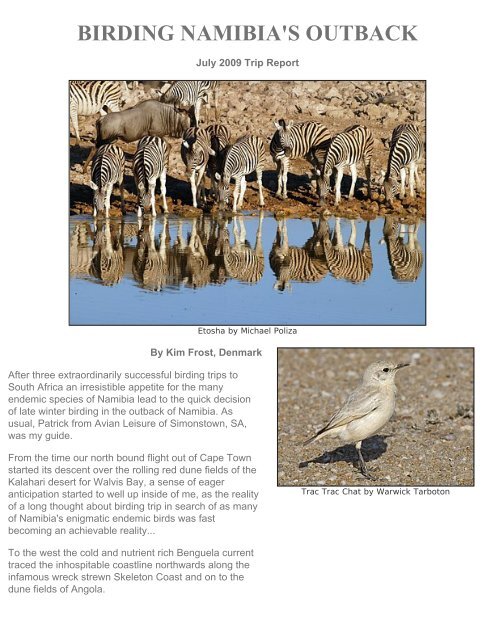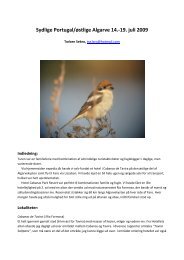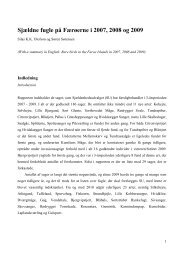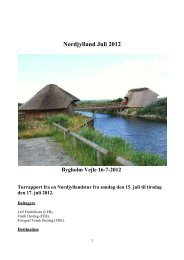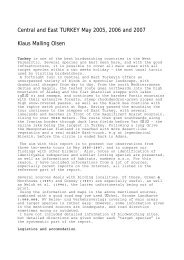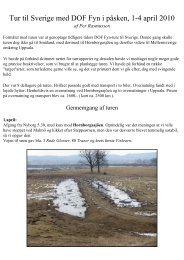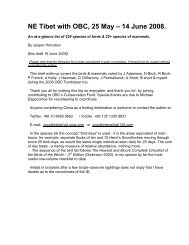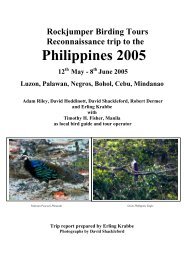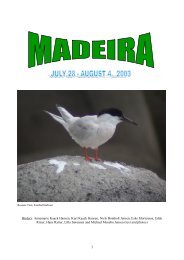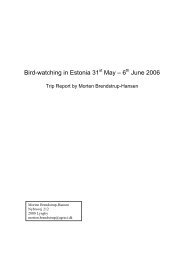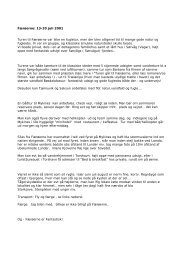Birding Tours Namibia, Etosha, birdwatching Namibia ... - Netfugl.dk
Birding Tours Namibia, Etosha, birdwatching Namibia ... - Netfugl.dk
Birding Tours Namibia, Etosha, birdwatching Namibia ... - Netfugl.dk
You also want an ePaper? Increase the reach of your titles
YUMPU automatically turns print PDFs into web optimized ePapers that Google loves.
BIRDING NAMIBIA'S OUTBACK<br />
July 2009 Trip Report<br />
<strong>Etosha</strong> by Michael Poliza<br />
By Kim Frost, Denmark<br />
After three extraordinarily successful birding trips to<br />
South Africa an irresistible appetite for the many<br />
endemic species of <strong>Namibia</strong> lead to the quick decision<br />
of late winter birding in the outback of <strong>Namibia</strong>. As<br />
usual, Patrick from Avian Leisure of Simonstown, SA,<br />
was my guide.<br />
From the time our north bound flight out of Cape Town<br />
started its descent over the rolling red dune fields of the<br />
Kalahari desert for Walvis Bay, a sense of eager<br />
anticipation started to well up inside of me, as the reality<br />
of a long thought about birding trip in search of as many<br />
of <strong>Namibia</strong>'s enigmatic endemic birds was fast<br />
becoming an achievable reality...<br />
Trac Trac Chat by Warwick Tarboton<br />
To the west the cold and nutrient rich Benguela current<br />
traced the inhospitable coastline northwards along the<br />
infamous wreck strewn Skeleton Coast and on to the<br />
dune fields of Angola.
Far out to sea a great grey fog bank was creeping eerily<br />
shorewards pushed by a light onshore westerly wind<br />
that would shroud the coastal plain in heavy fog during<br />
the course of the night. A dew point and cold current<br />
related phenomenon that has repeated itself with<br />
monotonous reliability over the millennia for the benefit<br />
of the many forms of moisture dependent life inhabiting<br />
the Namib Desert.<br />
Now with the bump of the undercarriage going down for<br />
the final approach the parallel lines of red sand dunes<br />
finally gave way to the sprawling gravel plains of the<br />
Namib Desert, geologically separated from the Kalahari<br />
by what remains of the non-perennial Kuiseb river<br />
wending its fossilized way westwards across the scrub<br />
dotted landscape to the salt pan system south of Walvis<br />
Bay.<br />
Damara Tern by Warwick Tarboton<br />
Immigration procedures were promptly attended to and<br />
in no time we had collected our hire car and first new<br />
‘tick' in the form of the pale race of the Trac Trac Chat<br />
in the car park, before heading out across the Namib<br />
plains with more lifers in mind.<br />
First off was the much sought after Dune Lark to add to<br />
my collection of South African larks already seen. Not<br />
one but several were observed, including a confiding<br />
pair that provided a close approach as they quietly<br />
foraged about in a nama melon encrusted tussock. An<br />
added bonus was the presence of three hyper active<br />
male Dusky Sunbirds sparking off one another in an<br />
acacia tree, a bird I had missed earlier down south in<br />
the Karoo.<br />
From here we headed directly across the dunes to the<br />
sprawling matrix of commercially mined salt pans dotted<br />
along the southern end of Walvis Bay in search of<br />
palearctic waders and, in particular, Damara Tern. This<br />
diminutive tern with its black bill and yellow legs winters<br />
far to the north off West Africa . However, we had been<br />
reliably informed that there was always a chance of one<br />
or two in the area provided we were persistent and<br />
allowed sufficient time for a thorough search of the tidal<br />
area.<br />
Orange River White-Eye by Warwick Tarboton<br />
Rosy-faced Lovebird by Warwick Tarboton<br />
After a series of up close views of Greater Flamingo<br />
and early wader arrivals in the form of Ruddy<br />
Turnstone, Curlew Sandpiper, still in resplendent<br />
breeding plumage, Ruff, Greenshank, Marsh Sandpiper
and Sanderling, we had a small white tern fly by and<br />
settle in perfect light a short distance away facing into<br />
the wind. Sure enough it proved to be our target bird<br />
and we enjoyed an extended scope view before<br />
heading back to town for the night.<br />
An early and fog bound start to the day kicked off with<br />
Orange River White-Eye in the guest house garden<br />
followed by African Reed Warbler, Black-chested Prinia,<br />
Dusky Sunbird, Southern Masked Weaver and Whitebacked<br />
Mousebird in a stand of isolated tamarisk trees.<br />
From Walvis Bay we took a direct line for Spitskop, and<br />
isolated granite inselberg situated in the heart of the<br />
Namib Desert , picking up Karoo Long-billed Lark, Chat<br />
Flycatcher, Stark's Lark, Grey-backed Sparrowlark in<br />
quick succession along the side of the road.<br />
A ‘fly by' of five very pale larks that could have been<br />
Gray's Lark didn't stop for further examination but the<br />
surrounding area delivered up excellent sightings of<br />
Double-banded Courser and Namaqua Sandgrouse.<br />
Closer to Spitskop, Ruppell's Korhaan, Monteiro's<br />
Hornbill, Sabota Lark, Pale-winged Starling, Lark-like<br />
Bunting, Rufous-eared Warbler, Red-eyed Bulbul and<br />
Mountain Wheatear were added to the list. Within the<br />
surrounding granite complex of mega sized boulders<br />
Chestnut-vented Tit-Babbler, Pririt Batis, Great<br />
Sparrow, Rosy-faced Lovebird, Red-headed Finch,<br />
Chestnut Weaver, Purple Roller and, best of all Herero<br />
Chat was soon added to the bag!<br />
Our afternoon route across a matrix of dry river beds<br />
and acacia dotted plains to the distant Erongo<br />
Mountains yielded views of Black-breasted and Brown<br />
Snake Eagle, Pale Chanting Goshawk, Greater Kestrel,<br />
Red-billed Francolin, Swallow-tailed Bee-eater, Acacia<br />
Pied Barbet, Marico Flycatcher, Southern Yellow-billed<br />
Hornbill, Red-crested Korhaan, Double-banded<br />
Sandgrouse, Namaqua Dove, Red-faced Mousebird,<br />
Bokmakierie, Yellow-bellied Eremomela and lastly a<br />
Freckled Nightjar ‘yapping' away at dusk to bring the<br />
day to a close.<br />
Red-billed Francolin<br />
White-tailed Shrike<br />
Pearl-spotted Owlet<br />
An early start into the surrounding boulder strewn hills<br />
and granite shields delivered early sightings of the<br />
enigmatic Hartlaubs Francolin, closely followed by Shorttoed<br />
Rock Thrush, White-tailed Shrike, Damara Rock<br />
Runner, Rosy-faced Lovebird, Scaly-feathered Finch,<br />
Long-billed Crombec, White-browed Sparrow Weaver,
Grey-backed Camaroptera, a pair of stunning Violeteared<br />
Waxbills and the multi-colored Green-winged<br />
Pytilia before we headed north to a lodge on the<br />
western edge of the <strong>Etosha</strong> National Park.<br />
On arrival our quest for new birds commenced afresh<br />
with Pygmy Falcon, Ruppell's Parrot, Bare-cheeked<br />
Babbler, Damara Red-billed Hornbill and Meve's<br />
Starling being added in quick succession. The birding in<br />
and around <strong>Etosha</strong> was proving to be as excellent as<br />
the rest of <strong>Namibia</strong>!<br />
A slow trawl through open woodland along the<br />
approach road yielded good views of Carp's Tit, Goldentailed<br />
Woodpecker, Black-backed Puffback, Crimsonbreasted<br />
Shrike, Southern White-crowned Shrike, Cape<br />
Penduline Tit - Southern Africa's smallest bird, Redeyed<br />
Bulbul, Groundscraper Thrush, Black-faced<br />
Waxbill and Pearl-spotted Owl to our now rapidly<br />
expanding list of sightings.<br />
Keeping an eye to the sky paid off in the form of great<br />
views of Augur Buzzard, as it circled low overhead,<br />
while loose flocks of Bradfield's Swift foraged low down<br />
over the open plain. Dusk at the waterhole provided<br />
good views of Double-banded Sandgrouse in the failing<br />
light....<br />
Traversing east across the <strong>Etosha</strong> National Park added<br />
Lappet-faced and White-backed Vulture, Tawny Eagle,<br />
Burchell's Courser, Northern Black Korhaan, Chestnutbanded<br />
Plover, Grey-backed and Chestnut-backed<br />
Sparrowlark, Red-capped Lark, a foraging party of the<br />
pale form of Spike-heeled Lark, Ant-eating Chat,<br />
Sociable Weaver, Lilac-breasted Roller, Palm Swift,<br />
Kori Bustard, the heaviest flying bird in the world, and<br />
the totally unexpected sight of a magnificent male<br />
African Lion striding purposefully across the open plain<br />
in the heat of the day…<br />
<strong>Namibia</strong> Lion<br />
Lilac-breasted Roller<br />
A lunch break in mopani woodland produced close up<br />
Golden-breasted Bunting by Warwick Tarboton<br />
views of two White-faced Owls and a single diminutive<br />
African Scops Owlet in their day time roosts, Grey Hornbill, Gabar Goshawk, White-crested Helmet Shrike<br />
and Violet Wood-Hoopoe, while a patch of acacia produced Pied Babbler, Bearded Woodpecker, Kalahari<br />
Scrub Robin and Barred Warbler.<br />
Dusk at a waterhole east of the Park provided floodlit views of a lone male Greater Painted-Snipe as an<br />
unexpected bonus bird feeding along the shoreline in a totally exposed position in the company of a family<br />
party of Blacksmith Plovers!
Further south on the final run back to Windhoek for the flight out we added Cinnamon and Goldenbreasted<br />
Bunting, Swainson's Francolin, Harlequin Quail, Small Button Quail, Fawn-colored Lark, Cape<br />
Glossy and Burchell's Starling, Red-billed Hornbill, Brown-crowned Tchagra, Familiar Chat, Ashy Tit,<br />
African Hoopoe, African Scimitarbill, Blue Waxbill, Desert and Rattling Cisticola.<br />
Aside from the more important birds singled out for mention within the mix of well over 150 recorded along<br />
the route, over thirty mammal species were recorded and several reptiles, including Puff Adder and Desert<br />
Chameleon were encountered.<br />
All in all a really great six day mid-winter safari across the deserts and Great Plains of central <strong>Namibia</strong>!<br />
Thanks go to Patrick & Marie Louise Cardwell of Avian Leisure www.avianleisure.com for organizing all<br />
arrangements of my most productive and enjoyable birding safari with a total of no less than 242 bird<br />
species.<br />
Kim Frost, MD & DMSc, Denmark.<br />
E-mail: frost@frostklinik.<strong>dk</strong> Cell phone +45 20 27 34 86<br />
For more information contact Marie-Louise on enquiries@avianleisure.com


